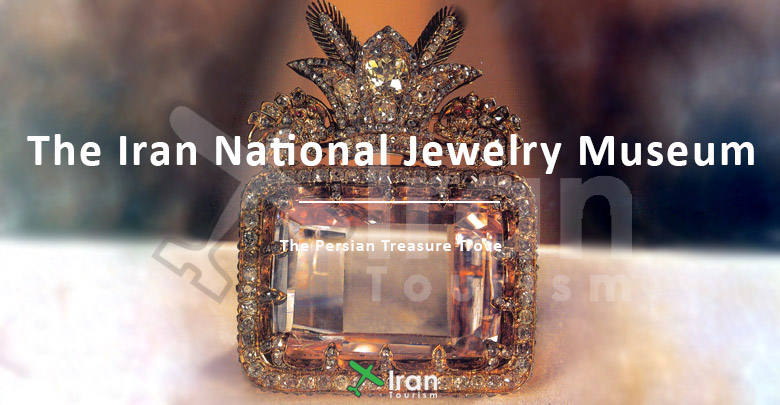The Iran National Jewelry Museum known locally as the “Muze-ye Javāherāt-e Mellī-ye Irān,” is a renowned cultural institution situated in Tehran, Iran. It houses one of the most extraordinary and valuable collections of jewelry and gemstones in the world. The museum’s history is closely tied to the rich and complex history of Iran itself.
Early Origins: The history of the Iran National Jewelry Museum can be traced back to the Safavid Dynasty in the 17th century. During the reign of Shah Abbas I, an extensive collection of jewelry and precious gems was amassed as a symbol of royal power and wealth. This collection was meant to symbolize the grandeur and prestige of the Persian Empire.
Expansion and Transition: Over the centuries, the collection continued to grow through subsequent dynasties, including the Qajar and Pahlavi dynasties. The collection not only expanded but also underwent various changes, as new pieces were added, and some were removed. However, the core of the collection remained intact, serving as a testament to the enduring fascination with precious jewels and gemstones in Persian culture.
The Iran National Jewelry Museum, known locally as the “Muze-ye Javāherāt-e Mellī-ye Irān,” is a renowned cultural institution situated in Tehran, Iran. It houses one of the most extraordinary and valuable collections of jewelry and gemstones in the world. The museum’s history is closely tied to the rich and complex history of Iran itself.
Early Origins: The history of the Iran National Jewelry Museum can be traced back to the Safavid Dynasty in the 17th century. During the reign of Shah Abbas I, an extensive collection of jewelry and precious gems was amassed as a symbol of royal power and wealth. This collection was meant to symbolize the grandeur and prestige of the Persian Empire.
Expansion and Transition: Over the centuries, the collection continued to grow through subsequent dynasties, including the Qajar and Pahlavi dynasties. The collection not only expanded but also underwent various changes, as new pieces were added, and some were removed. However, the core of the collection remained intact, serving as a testament to the enduring fascination with precious jewels and gemstones in Persian culture.
Transformation into a Museum: In 1967, during the reign of Mohammad Reza Shah Pahlavi, the decision was made to establish a museum dedicated solely to the royal jewelry collection. The National Treasury of Iran was created, and the collection was placed on public display. The museum was opened to the public in 1972, and it was named the “Iran National Jewelry Museum.”
The Crown Jewels: The museum’s most famous and prized possessions are undoubtedly the Iranian Crown Jewels. This stunning collection includes the Darya-ye Noor (Sea of Light) diamond, one of the world’s largest pink diamonds, and the Koh-i-Noor diamond, which has a long and storied history. The Iranian Crown Jewels also feature an array of crowns, tiaras, necklaces, and other jewelry items, many encrusted with exquisite gemstones, including emeralds, rubies, and sapphires.
Today, the museum continues to be a significant cultural institution in Iran, drawing visitors from around the world who come to marvel at the breathtaking beauty of the Iranian Crown Jewels and other precious artifacts on display. It is a place where history, art, and luxury converge, offering a glimpse into the opulent past of Persia and its enduring legacy in the world of jewelry.
Main National Jewels in This Museum

Empress Farah Emerald Tiara
- Princess Ashraf Ruby Diamond Tiara (Ashraf Pahlavi was the sister of the last king of Iran)
- Empress Farah Emerald Tiara (Farah is a spouse of the last king of Iran)
- The Sword of Fath-Ali Shah Qajar (was the second king of Qajar dynasty)
- The Great Globe (made of gold by Naser-o-din Shah, one of the Qajar kings)
- The Sun Throne (تخت خورشید -Takht-e Khurshīd was made for Fath-Ali-shah king, Qajar dynasty)
- Sword of Nader Shah (Nader Shah was the founder of the Afsharid dynasty)
- Pahlavi crown (ordered by Pahlavi kings)
- Shield of Nader Shah
- Takhte Tavoos bed (built by the order of Fath-Ali Shah Qajar)
- Kiani Crown (built by the order of Fath-Ali Shah Qajar)
- Jogheh Naderi (Naderi Paisley)
- The Noor-ol-Ain Tiara (Empress Farah Pahlavi)
- Naderi throne
- A chest filled with pearls
- Shah’s Coronation Belt
- Jeweled Dish Cover
- Golden Flagon
And other brilliant national jewels.
The National Jewelry Museum tells us the stories about Persian kings from ancient times to these days.
Phone numbers: 0098-21-6446-3785, 6446 3869, 6446 3870
Jewelry Museum Tehran Opening Times
It starts from 2:00 PM to 4:30 PM (Saturday-Tuesday)
Iran Travel Guide would like to inform you that the Iran National Jewelry Museum is closed on Wednesdays, weekends, and Public and Bank Holidays.
Ticket Price is about 200,000 RLS per person. Please note that children under 12 years old are not allowed to visit.
They will sell a guidebook with a price of 40,000 RLS in the entrance shop or you can ask for a tour guide in English, French, German, or Arabic and it’s included in your ticket price.
All of your stuff must be left at reception.
Accessibility to the Jewelry Museum
The National Jewelry Museum is located along Ferdowsi (فردوسی –pher- Do- si) Street near the Jomhouri (جمهوری- Jom-Hoo-rii) Street and opposite to Turkey Embassy and Germany Embassy.
Iran tourism suggests getting on the Tehran metro (line 1- red line) and getting off Sa’adi (سعدی) metro station then walking ahead to the west and Ferdowsi street.
You will reach the National Jewelry Museum in 10 minutes and the distance is about 600 meters.
Interesting Facts About The National Jewelry Museum of Iran
The Iran National Jewelry Museum is positioned in the heart of Tehran City on the Central Bank of Iran and it has one of the finest and most extensive collections of jewelry in Iran which includes national jewels from the Safavid, Afsharid, Qajar, and Pahlavi era.
The Iran Jewelry Museum was built in 1955 and officially opened at the same time as the Central Bank of Iran establishment in 1960 by “Mohammad Reza Shah” (محمد رضا شاه – The last king of Iran from the Pahlavi dynasty). Before that national jewel was kept in Golestan Palace by the Qajar kings.
Darya-e-Nour (دریای نور – Persian meaning Sea of Light) and Koh-e-Nour (کوه نور – Persian meaning Mountain of Light) are the most prominent diamonds in the world and they belong to national jewels of Iran; but only Darya-e-Nour available in Iran museum and Koh-e-Nour is on London right now. however, they have long stories during that time!
Both fantastic diamonds were brought by Nader Shah Afshar (نادر شاه افشار- Nader is an Afsharid king) in 1739 from India and he gave current names to diamonds.
Koh-e-Nour moved from Iran to India then finally the United Kingdom took it from India and sent it to London. Darya-e-Nour contains the famous, oldest, and biggest Pink Diamond in the world.
According to the new rule which was approved by Congress in 1929 in Reza Shah Pahlavi’s era, every paper money has to have a financial back-up in the bank and they agreed that national jewels would be a financial back-up of paper money and Rials as Iranian currency.



No comment